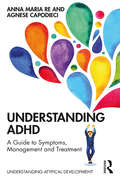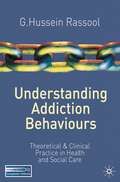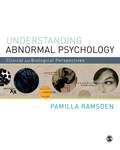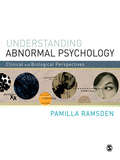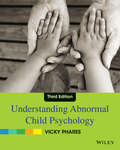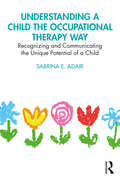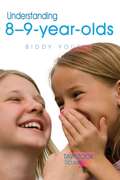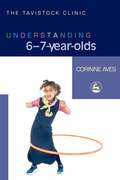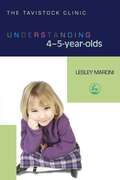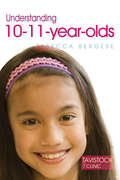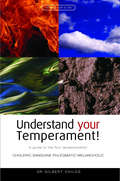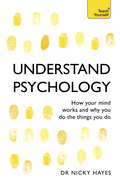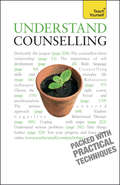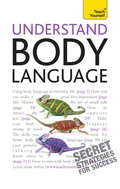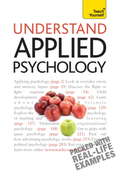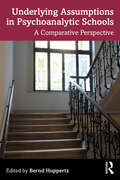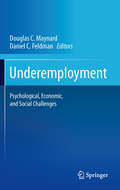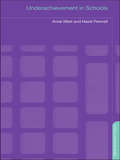- Table View
- List View
Understanding ADHD: A Guide to Symptoms, Management and Treatment (Understanding Atypical Development)
by Anna Maria Re Agnese CapodieciThis essential guide provides accessible, concise, evidence-based guidelines on Atttention Deficit Hyperactivity Disorder (ADHD), offering a deeper scientific understanding of the condition and its consequences. It offers ideas and insights for managing the condition in daily family life and promoting the most effective self-regulation strategies for children and adolescents, allowing parents to better understand the origins of their child’s behaviour and avoid potential negative consequences. In this straightforward text, Capodieci and Re set out the basic theories on ADHD and cover key topics including parent-child relationships, helping children understand their condition, friendships with peers, comorbidities, classroom strategies, and how families and professionals can best work together. Taking into account the most recent updates to the DSM-5 definition of ADHD, the authors emphasise the importance of a multifocal approach to the treatment of ADHD, involving the child’s teachers, parents and peers, to better develop family and peer relationships. They offer strategies for the classroom, for good sleep and for healthy eating and physical activity, and support for any other learning, language, movement and emotional problems an ADHD child might have. Understanding ADHD will be essential reading for parents of children with ADHD, as well as health, education and social care professionals involved in the field.
Understanding Addiction Behaviours: Theoretical and Clinical Practice in Health and Social Care
by G.Hussein RassoolUnderstanding addiction has never been more important, as many professionals, from counsellors and nurses, to social workers and healthpsychologists, encounter addictive behaviour on a daily basis. Looking at addiction in all of its forms, this multi-disciplinary book provides a comprehensive introduction to the substances and the activities which can lead to excessive and addictive behaviour. It discusses pharmacological addictions, including both legal and illegal substances. It also covers non-pharmacological dependencies (such as internet addiction, eating disorders, gambling and sexual addiction) which, despite their prevalence, are often absent from the literature on addiction. Drawing on the field's broad evidence base, the book features: Coverage of eleven types of addictive substances and activities, outlining signs, symptoms, adverse consequences and assessment and intervention strategies for each; A range of engaging reflective activities and case studies to link theoretical discussion directly to practice; Analysis of the broader context of addiction, including dual diagnosis and harm reduction, and issues relating to diversity and service provision;Offering a rigorous introduction to the full spectrum of addictive behaviour, this book is essential reading for anyone seeking to understand the nature of addiction for contemporary practice.
Understanding Addiction Behaviours: Theoretical and Clinical Practice in Health and Social Care
by G.Hussein RassoolUnderstanding addiction has never been more important, as many professionals, from counsellors and nurses, to social workers and health psychologists, encounter addictive behaviour on a daily basis.Looking at addiction in all of its forms, this multi-disciplinary book provides a comprehensive introduction to the substances and the activities which can lead to excessive and addictive behaviour. It discusses pharmacological addictions, including both legal and illegal substances. It also covers non-pharmacological dependencies (such as internet addiction, eating disorders, gambling and sexual addiction) which, despite their prevalence, are often absent from the literature on addiction.Drawing on the field's broad evidence base, the book features:- Coverage of eleven types of addictive substances and activities, outlining signs, symptoms, adverse consequences and assessment and intervention strategies for each- A range of engaging reflective activities and case studies to link theoretical discussion directly to practice- Analysis of the broader context of addiction, including dual diagnosis and harm reduction, and issues relating to diversity and service provisionOffering a rigorous introduction to the full spectrum of addictive behaviour, this book is essential reading for anyone seeking to understand the nature of addiction for contemporary practice.
Understanding Abnormal Psychology: Clinical and Biological Perspectives (PDF)
by Pamilla RamsdenUnderstanding Abnormal Psychology provides a thorough understanding of abnormal psychology with a focus on the integration of psychology, biology and health. It goes beyond a descriptive overview of clinical disorders to provide a critical appreciation of the multifaceted aspects of mental illness. Each disorder is clearly and succinctly explained with the support of case studies. These examples are then used to introduce the debates surrounding current research, the biology of abnormal disorders and standards of treatment. The bridge between the biological elements of brain functioning and the psychological mechanisms that are responsible for coping and adjustment is thoroughly explored. This valuable consideration of the range of elements involved in the diagnosis and treatment of clinical disorders will provide you with a broad and critical understanding of this complex and fascinating field. Visit the companion website at www.sagepub.co.uk/ramsden with a number of useful features for students, including a flipcard glossary of key terms from the textbook and a test bank of interactive self-assessment multiple-choice questions.
Understanding Abnormal Psychology: Clinical and Biological Perspectives
by Pamilla RamsdenUnderstanding Abnormal Psychology provides a thorough understanding of abnormal psychology with a focus on the integration of psychology, biology and health. It goes beyond a descriptive overview of clinical disorders to provide a critical appreciation of the multifaceted aspects of mental illness. Each disorder is clearly and succinctly explained with the support of case studies. These examples are then used to introduce the debates surrounding current research, the biology of abnormal disorders and standards of treatment. The bridge between the biological elements of brain functioning and the psychological mechanisms that are responsible for coping and adjustment is thoroughly explored. This valuable consideration of the range of elements involved in the diagnosis and treatment of clinical disorders will provide you with a broad and critical understanding of this complex and fascinating field. Visit the companion website at www.sagepub.co.uk/ramsden with a number of useful features for students, including a flipcard glossary of key terms from the textbook and a test bank of interactive self-assessment multiple-choice questions.
Understanding Abnormal Child Psychology
by Vicky PharesUnderstanding Abnormal Child Psychology, 3rd edition emphasizes developmental psychopathology as a means for understanding and treating abnormal behavior in children. The text emphasizes strengths and healthy outcomes as a means for designing effective therapies to help children and families, as well as focusing on prevention as a cornerstone of managing child behavior. Throughout this book, special attention is given to issues of diversity, inclusion, and understanding. The text also examines the relationships between children and their fathers as well as with other primary figures within families (i.e., siblings, step-parents, care-taking grandparents, foster parents, etc.). The Third Edition has been updated to include DSM-5.
Understanding a Child the Occupational Therapy Way: Recognizing and Communicating the Unique Potential of a Child
by Sabrina E. AdairThis book uses an occupational therapy way of thinking to guide the reader towards observing, understanding, and communicating the needs of children to foster a supportive environment. Presented in accessible, everyday language, this book takes a holistic approach of looking at a child from what makes them a unique person, what activities they are trying to accomplish, and what environment they are in. Each chapter helps readers identify, describe, and clearly articulate a different aspect of the child’s environment and how it may affect them, the way that they process different sensory inputs, what their behaviors may be telling us, and how they learn. By recognizing each child’s unique story and effectively communicating their story to others, the reader can identify the most effective ways to support a child to meet a child’s needs and set them up for success. Therapists, educators, parents, and childcare workers will all benefit from the simple strategies outlined in this book to enrich a child’s learning.
Understanding a Child the Occupational Therapy Way: Recognizing and Communicating the Unique Potential of a Child
by Sabrina E. AdairThis book uses an occupational therapy way of thinking to guide the reader towards observing, understanding, and communicating the needs of children to foster a supportive environment. Presented in accessible, everyday language, this book takes a holistic approach of looking at a child from what makes them a unique person, what activities they are trying to accomplish, and what environment they are in. Each chapter helps readers identify, describe, and clearly articulate a different aspect of the child’s environment and how it may affect them, the way that they process different sensory inputs, what their behaviors may be telling us, and how they learn. By recognizing each child’s unique story and effectively communicating their story to others, the reader can identify the most effective ways to support a child to meet a child’s needs and set them up for success. Therapists, educators, parents, and childcare workers will all benefit from the simple strategies outlined in this book to enrich a child’s learning.
Understanding 8-9-Year-Olds (PDF)
by Biddy Youell Jonathan BradleyUnderstanding 8-9-Year-Olds describes how children grow and change as they move further away from reliance on home and family, out into the world of school and community. Children of this age develop preferences as well as opinions based on their experience of new relationships and activities. For many children, it is a period of relative calm as they develop through new skills while accumulating knowledge. Biddy Youell looks at the ways in which eight and nine year olds experience their world and highlights some of the difficulties that may hinder their emotional, social or educational development. This accessible book provides valuable insights that will help parents, educators and carers better understand and relate to children during these middle years of childhood.
Understanding 8-9-Year-Olds
by Biddy Youell Jonathan BradleyUnderstanding 8-9-Year-Olds describes how children grow and change as they move further away from reliance on home and family, out into the world of school and community. Children of this age develop preferences as well as opinions based on their experience of new relationships and activities. For many children, it is a period of relative calm as they develop through new skills while accumulating knowledge. Biddy Youell looks at the ways in which eight and nine year olds experience their world and highlights some of the difficulties that may hinder their emotional, social or educational development. This accessible book provides valuable insights that will help parents, educators and carers better understand and relate to children during these middle years of childhood.
Understanding 6-7-Year-Olds (PDF)
by Corinne Aves Jonathan BradleyWhat challenges do 6-7-year-olds face as they learn new skills and face different social situations? How do their perceptions of the world change? How can we best support them in their move towards greater independence? This accessible book provides a wealth of information to help parents, educators and carers better relate to children at this exciting, yet demanding, stage of development. From the new-found sense of rivalry between siblings or classmates, to the anxieties children feel when making new friends, Corinne Aves offers guidance on encouraging children's development and helping them to cope with changing expectations of their behaviour. She discusses the various struggles in these children's lives – such as the conflict between a child's continuing desire to please his parents and the pressure to follow the leads of his friends – and gives tips for supporting children's increasing understanding of morality. Chapters on both school and family life explain the need for discipline and order in 'middle childhood', while specific areas of development such as reading skills and learning difficulties are addressed with sensitivity and insight. Understanding 6-7-Year-Olds will prove an enlightening read for anyone hoping to better understand children at this important stage of their lives.
Understanding 6-7-Year-Olds
by Corinne Aves Jonathan BradleyWhat challenges do 6-7-year-olds face as they learn new skills and face different social situations? How do their perceptions of the world change? How can we best support them in their move towards greater independence? This accessible book provides a wealth of information to help parents, educators and carers better relate to children at this exciting, yet demanding, stage of development. From the new-found sense of rivalry between siblings or classmates, to the anxieties children feel when making new friends, Corinne Aves offers guidance on encouraging children's development and helping them to cope with changing expectations of their behaviour. She discusses the various struggles in these children's lives – such as the conflict between a child's continuing desire to please his parents and the pressure to follow the leads of his friends – and gives tips for supporting children's increasing understanding of morality. Chapters on both school and family life explain the need for discipline and order in 'middle childhood', while specific areas of development such as reading skills and learning difficulties are addressed with sensitivity and insight. Understanding 6-7-Year-Olds will prove an enlightening read for anyone hoping to better understand children at this important stage of their lives.
Understanding 4-5-Year-Olds (PDF)
by Jonathan Bradley Lesley MaroniUnderstanding 4-5-year-olds gives a thoughtful overview of the challenges that children face as they gradually move away from a strong attachment to their families and turn towards the wider world of school and life outside the family. Lesley Maroni discusses the critical social and emotional developments at this age, including identity, independence and sibling rivalry, the transition to school and friendships with peers, coping with illness and loss, and gender differences. The author also shows how 4-5-year-olds explore real issues using the protective safety of pretend play and their imagination. This accessible book provides valuable insights and a wealth of case examples that will help parents, educators and carers better understand and relate to children at this demanding, yet exciting, stage of development.
Understanding 4-5-Year-Olds
by Lesley Maroni Jonathan BradleyUnderstanding 4-5-year-olds gives a thoughtful overview of the challenges that children face as they gradually move away from a strong attachment to their families and turn towards the wider world of school and life outside the family. Lesley Maroni discusses the critical social and emotional developments at this age, including identity, independence and sibling rivalry, the transition to school and friendships with peers, coping with illness and loss, and gender differences. The author also shows how 4-5-year-olds explore real issues using the protective safety of pretend play and their imagination. This accessible book provides valuable insights and a wealth of case examples that will help parents, educators and carers better understand and relate to children at this demanding, yet exciting, stage of development.
Understanding 10-11-Year-Olds (PDF)
by Jonathan Bradley Rebecca BergeseUnderstanding 10-11-Year-Olds introduces the challenges that face children as they start to make their transition from childhood into adolescence. Children at this age begin to express independence and confidence in their capability that may extend beyond their direct experience. Adults caring for their well-being need to monitor the new dimensions in the child's life, such as competitiveness and its impact on relationships at school and at home. Rebecca Bergese guides the reader through the broad range of emotional and social challenges experienced by children as they are encouraged to take on greater responsibility. This book is essential reading for parents, carers and professionals who are seeking to understand and support a child at this vulnerable stage of development.
Understanding 10-11-Year-Olds
by Jonathan Bradley Rebecca BergeseUnderstanding 10-11-Year-Olds introduces the challenges that face children as they start to make their transition from childhood into adolescence. Children at this age begin to express independence and confidence in their capability that may extend beyond their direct experience. Adults caring for their well-being need to monitor the new dimensions in the child's life, such as competitiveness and its impact on relationships at school and at home. Rebecca Bergese guides the reader through the broad range of emotional and social challenges experienced by children as they are encouraged to take on greater responsibility. This book is essential reading for parents, carers and professionals who are seeking to understand and support a child at this vulnerable stage of development.
Understand Your Temperament!: A Guide to the Four Temperaments - Choleric, Sanguine, Phlegmatic, Melancholic
by Dr. Gilbert ChildsHow can we better understand ourselves and others? The classical concept of the four temperaments - the four personality types characterized as the fiery choleric, the airy sanguine, the watery phlegmatic and the earthy melancholic - has been revered by many significant thinkers over the ages. In a refreshing treatment Dr Childs demonstrates how this ancient doctrine remains relevant to the present day. He shows us how we can recognize the temperaments in our fellow human beings as well as in ourselves, and how to understand their workings. A comprehension of their influence can boost personal development, as well as help improve interpersonal relationships. Conversational in tone and easily digestible, this book features fascinating discussions of the relationships between adults of various temperaments. Childs reviews matters of compatibility in partnership, family and workplace situations, liberally spicing his commentary with amusing examples of likely scenarios. He investigates the origins and manifestations of the temperaments in both their psychological and physiological aspects. There is also a section on the temperaments of children, with helpful and practical advice on dealing with individual issues. DR GILBERT CHILDS attended the Steiner teacher training course at Michael Hall after war service. He later studied at four universities, his doctoral thesis being entitled 'Steiner Education as Historical Necessity'. After teaching at State and Steiner schools he spent twenty years as a tutor in a further education college for severely physically disabled students. He is, in retirement, a full-time author and keen gardener. His published works include "Your Reincarnating Child" and "Truth, Beauty and Goodness".
Understand Psychology: How Your Mind Works and Why You Do the Things You Do (Teach Yourself)
by Nicky HayesA FASCINATING INSIGHT INTO WHAT MAKES US TICKThe bestselling Understand Psychology explains basic psychological processes and how they influence us in all aspects of everyday life. It explores why we are the way we are, how we came to be that way, and what we might do to change seemingly fundamental traits. The book puts psychology in context, using non-technical language to analyze everyday situations. It is a comprehensive introduction that shows how human experience can be understood on many levels.Understand Psychology takes you through every aspect of the subject, from child development and social influences to the role of memories and emotions. You will discover how we interact with each other, why we dream, what motivates us, why children need to play and whether watching TV is bad for you.Now fully revised and updated, this 6th edition of the bestselling guide includes brand new material on mindfulness, social living, focusing in particular on shyness and loneliness and social media, coping with stress, decision making and forensic psychology, addiction and modern drugs, cognitive neuropsychology, and the psychology of learning, including teaching, exams and exam stress.The clear structure, packed full of practical examples, makes it easy to learn the essentials you really need to know.ABOUT THE SERIESPeople have been learning with Teach Yourself since 1938. With a vast range of practical, how-to guides covering language learning, lifestyle, hobbies, business, psychology and self-help, there's a Teach Yourself book for whatever you want to do. Join more than 60 million people who have reached their goals with Teach Yourself, and never stop learning.
Understand Counselling: Learn Counselling Skills For Any Situations (Teach Yourself)
by Aileen MilneUnderstand Counselling will give you a clear understanding of the main counselling theories and help you develop vital counselling skills. It will introduce you to the three main branches of counselling - psychodynamic therapy, person-centred therapy and cognitive behavioural therapy - and familiarize you with the key features of each one. Whether you are interested in training as a counsellor, are considering counselling yourself or simply want to become a better communicator, this book will give you confidence and understanding.NOT GOT MUCH TIME?One, five and ten-minute introductions to key principles to get you started.AUTHOR INSIGHTSLots of instant help with common problems and quick tips for success, based on the author's many years of experience.TEST YOURSELFTests in the book and online to keep track of your progress.EXTEND YOUR KNOWLEDGEExtra online articles at www.teachyourself.com to give you a richer understanding of counselling.FIVE THINGS TO REMEMBERQuick refreshers to help you remember the key facts.TRY THISInnovative exercises illustrate what you've learnt and how to use it.
Understand Body Language: Teach Yourself (Teach Yourself)
by Gordon WainwrightTeach Yourself - the world's leading learning brand - is relaunched in 2010 as a multi-platform experience that will keep you motivated to achieve your goals. Let our expert author guide you through this brand new edition, with personal insights, tips, energising self-tests and summaries throughout the book. Go online at www.teachyourself.com for tests, extension articles and a vibrant community of like-minded learners. And if you don't have much time, don't worry - every book gives you 1, 5 and 10-minute bites of learning to get you started. - A bestseller, now fully updated with the very latest on body language and non-verbal communication - The only title to give you practical exercises to help you understand your own and other peoples' body language - Unlike other titles, this is not restricted to the workplace but shows you how to understand what other people are saying in every social and domestic situation - Includes the very latest on NLP and how to communicate more effectively through its useWe all use body language. Over 90% of all face-to-face communication is non-verbal, and the silent messages of body language often reveal more than the spoken word in conveying true feelings. These messages are particularly significant in influencing first impressions and the self-image we project to others.Now updated for the 21st century with the very latest on NLP and other cutting edge research, Teach Yourself Body Language gives you the knowledge and understanding to be able to use and interpret body language more effectively. It includes practical exercises that will enhance your understanding of non-verbal communication, and it also explores the use of body language in personal and professional situations.All aspects of body language are covered including features of the workplace and features exhibited in an international context.
Understand Applied Psychology: Teach Yourself (Teach Yourself)
by Nicky HayesUnderstand Applied Psychology shows how basic psychological processes are relevant to everyday situations and contexts. From education to occupational psychology, this book provides a comprehensive look at psychology in almost every area of day-to-day living. It covers 18 different areas of applied psychology, explaining how psychologists work in the community as a whole and how psychology is applied to working life and broader aspects of living. The book also includes well-developed but unknown areas such as space psychology and eco-psychology, showing the scope of applied psychology and giving ideas for other areas where it could usefully contribute to our everyday lives.NOT GOT MUCH TIME?One, five and ten-minute introductions to key principles to get you started.AUTHOR INSIGHTSLots of instant help with common problems and quick tips for success, based on the author's many years of experience.TEST YOURSELFTests in the book and online to keep track of your progress.EXTEND YOUR KNOWLEDGEExtra online articles at www.teachyourself.com to give you a richer understanding of applied psychology.FIVE THINGS TO REMEMBERQuick refreshers to help you remember the key facts.TRY THISInnovative exercises illustrate what you've learnt and how to use it.
Underlying Assumptions in Psychoanalytic Schools: A Comparative Perspective
by Bernd HuppertzThis book offers a comparative study of the major schools of psychoanalysis by exploring their historical development, their differences and similarities, and the underlying assumptions made by each. Encompassing the expertise of colleagues from different schools of psychoanalytic thought, each chapter explores a particular perspective, defining specific theoretical assumptions, theories of etiology, and implications for technique, as well as providing each author’s view on the historical development of key psychoanalytic concepts. With contributions from leading authors in the field, and covering both historical and international schools, the book provides an enlightening account that will prove essential to psychoanalytic practitioners and students of psychoanalysis and the history of medicine.
Underlying Assumptions in Psychoanalytic Schools: A Comparative Perspective
This book offers a comparative study of the major schools of psychoanalysis by exploring their historical development, their differences and similarities, and the underlying assumptions made by each. Encompassing the expertise of colleagues from different schools of psychoanalytic thought, each chapter explores a particular perspective, defining specific theoretical assumptions, theories of etiology, and implications for technique, as well as providing each author’s view on the historical development of key psychoanalytic concepts. With contributions from leading authors in the field, and covering both historical and international schools, the book provides an enlightening account that will prove essential to psychoanalytic practitioners and students of psychoanalysis and the history of medicine.
Underemployment: Psychological, Economic, and Social Challenges
by Douglas C. Maynard and Daniel C. FeldmanUnderemployment – when people are employed in some way that is insufficient, such as being overqualified or working part-time when one desires full-time employment – is a challenge faced by all industrialized nations and their organizations and individuals. Just like unemployment, some level of underemployment exists even in the best of times, but it becomes more pervasive when the job market is weak. Given the current economic climate in North America and abroad, researchers and scholars in various disciplines (psychology, business, sociology, economics) are becoming more interested in investigating the effects of underemployment and identifying possible practical solutions. Underemployment synthesizes the current understanding of the phenomenon by bringing together scholars with diverse perspectives and expertise with the aim of informing and guiding the next generation of underemployment research.
Underachievement In Schools (PDF)
by Anne West Hazel PennellThere is greater pressure for schools to meet certain levels of pupil achievement now more than ever before. Teachers and policy-makers are looking for ways to ensure pupils are not underachieving, and to do this must have some understanding of the causes of underachievement. This timely book examines different levels of achievement of pupil groups and the reasons behind them. The authors highlight ways in which schools and policy-makers might improve achievement through changes in policy and practice. Some of the topics considered are: * What is underachievement? * Social background and achievement * School structures and achievement * Schools raising attainment Underachievement in Schools will be a valuable resource for anyone involved with school policy as well as teachers and those training to teach.
